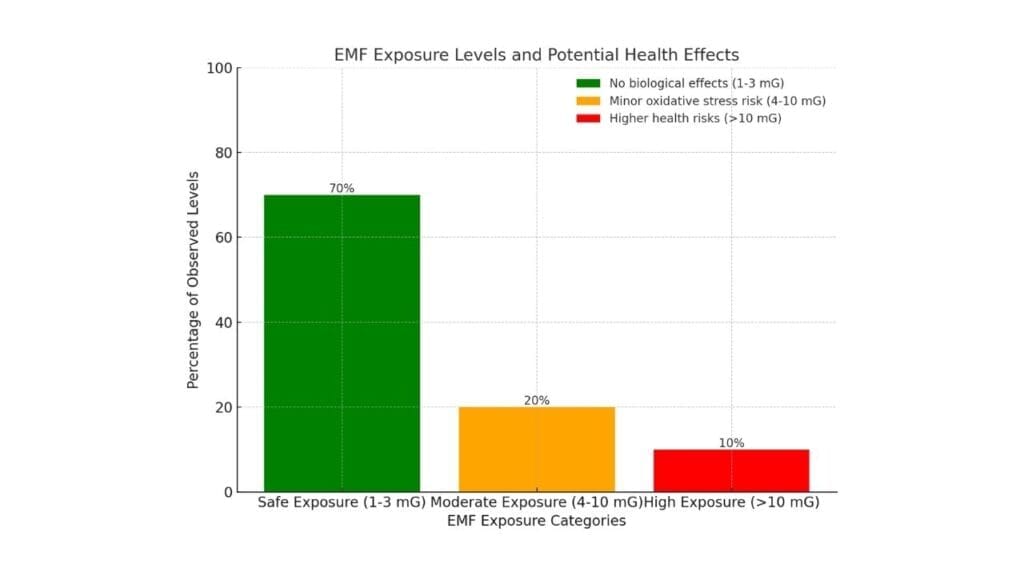Infrared saunas are gaining popularity for their health benefits, but concerns about electromagnetic fields (EMF) have led to a growing interest in “low EMF” saunas. EMF refers to the energy waves produced by electronic devices, including infrared saunas, which could potentially impact health.
Research, such as a 2016 study published in the International Journal of Environmental Research and Public Health, highlights possible biological effects of EMF exposure, including oxidative stress and cellular changes. Another study published in Environmental International in 2013 points to potential long-term health risks, particularly from prolonged exposure to electromagnetic radiation.
With this increasing awareness, consumers are seeking safer options, but what does “low EMF” really mean, and why is it important? Let’s dive in and explore this concept in detail.
What is EMF?
EMF stands for electromagnetic fields, which are invisible energy waves created by electrically charged objects.
They come in two main types: extremely low frequency (ELF) and radiofrequency (RF).
ELF is typically generated by household appliances, power lines, and electronics, while RF is emitted by wireless devices like cell phones and Wi-Fi routers.
EMF Levels in Saunas
Infrared saunas generate EMF through their heating elements and electrical wiring. Unlike traditional saunas that rely on steam or heated stones, infrared saunas use radiant heat, which requires electronic components.
As a result, they can produce EMF at varying levels, depending on the quality of their design and materials.
Understanding the specific EMF exposure in saunas is key to making informed choices about which ones are safest to use.
What Does "Low EMF" Actually Mean?
“Low EMF” refers to infrared saunas designed to minimize electromagnetic field exposure, but the term lacks a standardized definition.
It generally implies that the sauna emits EMF levels significantly lower than those of conventional electronic devices, but what qualifies as “low” can vary.
Manufacturers often measure EMF levels in milligauss (mG), with lower readings being better. For perspective, some saunas advertise EMF levels below 3 mG, as this is considered safe for long-term exposure based on guidelines from agencies like the International Commission on Non-Ionizing Radiation Protection (ICNIRP).
However, not all brands provide consistent testing or adhere to independent certification standards, making it important to dig deeper into their claims.
Why Low EMF Matters in Infrared Saunas

Health and Wellness Perspective
Low EMF matters because prolonged exposure to high levels of electromagnetic fields may have potential health risks. Studies, including those previously mentioned, have linked high EMF exposure to biological effects like oxidative stress and cellular damage.
While the research isn’t conclusive for low-level exposure, many people prefer to minimize their EMF exposure to align with their health-conscious lifestyle. Infrared saunas are marketed for relaxation and detoxification, so reducing EMF aligns with their wellness goals.
The graphical above shows EMF exposure levels and their potential health effects based on categorized exposure ranges. The chart shows:
- Safe Exposure (1-3 mG): 70% of scenarios observed, with no significant biological effects reported.
- Moderate Exposure (4-10 mG): 20% of scenarios, with potential oxidative stress as a concern.
- High Exposure (>10 mG): 10% of scenarios, associated with increased risk of cellular changes.
As people become more aware of the potential impacts of EMF, they are looking for safer alternatives. Low EMF saunas appeal to those who value non-toxic living and want to make their wellness routines as safe as possible.
However, it’s essential to verify claims, as “low EMF” can sometimes be used as a marketing buzzword without proper testing or certification to back it up.
What is a Safe EMF Level?
A safe EMF level generally falls below 3 milligauss (mG) for prolonged exposure, according to many health and safety guidelines.
While there is no universal standard for what constitutes a “safe” level, organizations like the International Commission on Non-Ionizing Radiation Protection (ICNIRP) and other regulatory bodies suggest limits that aim to minimize potential health risks.
For reference:
- 1-3 mG: Considered safe for long-term exposure, with no significant biological effects observed.
- 4-10 mG: May pose minor risks, such as increased oxidative stress.
- Above 10 mG: Potentially linked to higher risks, including cellular changes or other biological effects, especially with prolonged exposure.
When choosing an infrared sauna, aim for one with EMF levels consistently measured below 3 mG in all user-accessible areas, particularly near the seating and heating panels.
This aligns with common safety thresholds while ensuring peace of mind during use.
How to Choose a Truly Low EMF Infrared Sauna

Steps to Evaluate Claims
Not all “low EMF” saunas are created equal, so it’s important to scrutinize the manufacturer’s claims. Look for saunas that provide independent testing results from credible organizations.
A reliable company will offer documentation showing measured EMF levels in milligauss (mG) at various points within the sauna, especially near the seating area where users spend most of their time.
Materials and Design Features
The materials and design of the sauna play a huge role in minimizing EMF. High-quality saunas use shielding techniques, such as grounding wires, to reduce EMF emissions.
Additionally, premium saunas incorporate low-EMF heating elements and electrical systems that are specifically designed to emit minimal electromagnetic radiation.
Questions to Ask Before Buying
- Does the manufacturer provide certified test results?
- What is the EMF level near the heating panels and seating area?
- Are the materials used for construction safe and non-toxic?
Taking these steps will ensure you’re investing in a sauna that supports your wellness goals without unnecessary EMF exposure.
Misconceptions About Low EMF
- Myth: Low EMF Means No EMF
- One of the biggest misconceptions is that “low EMF” saunas are completely free of electromagnetic fields. This is not true. Any electronic device generates some level of EMF, and infrared saunas are no exception. The goal of low EMF saunas is to reduce exposure to levels considered safe, not to eliminate EMF entirely.
- Myth: All Low EMF Claims Are Accurate
- Another misconception is that all manufacturers’ claims of low EMF are trustworthy. Unfortunately, not all companies back their claims with independent testing. Some may only measure EMF in certain parts of the sauna while ignoring higher levels in other areas, such as near electrical wiring. Always request test reports to verify the claims.
- Putting EMF in Context
- While reducing EMF exposure is important, it’s also essential to understand the context. The brief exposure you get from using an infrared sauna a few times a week is far less than the constant EMF exposure from devices like smartphones or Wi-Fi routers. Balancing overall lifestyle habits is key to managing your total EMF exposure.
Final Thoughts About Low EMF
Low EMF infrared saunas are a smart choice for anyone looking to prioritize health and safety while enjoying the benefits of infrared therapy. EMF, while present in all electronic devices, can be minimized with well-designed saunas that focus on reducing exposure to safe levels. This makes it easier to relax and focus on wellness without worrying about unnecessary risks.
When shopping for a low EMF sauna, don’t just rely on marketing terms. Look for saunas that provide independent testing and show consistent low EMF readings, especially in areas where you’ll spend most of your time. It’s about making an informed decision and finding the right balance between safety and functionality.
Don’t worry. Most, if not all, of our reviewed products do not contain EMF levels higher than they’re supposed to be. Here are our most recent sauna reviews below.







